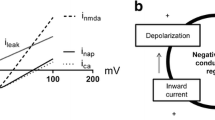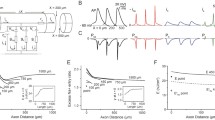Abstract
Reduction of the morphological complexity of actual neurons into accurate, computationally efficient surrogate models is an important problem in computational neuroscience. The present work explores the use of two morphoelectrotonic transformations, somatofugal voltage attenuation (AT cables) and signal propagation delay (DL cables), as bases for construction of electrotonically equivalent cable models of neurons. In theory, the AT and DL cables should provide more accurate lumping of membrane regions that have the same transmembrane potential than the familiar equivalent cables that are based only on somatofugal electrotonic distance (LM cables). In practice, AT and DL cables indeed provided more accurate simulations of the somatic transient responses produced by fully branched neuron models than LM cables. This was the case in the presence of a somatic shunt as well as when membrane resistivity was uniform.
Similar content being viewed by others
References
Agmon-Snir H (1995) A novel theoretical approach to the analysis of dendritic transients. Biophys. J. 69:1633-1656.
Agmon-Snir H, Segev I (1993) Signal delay and input synchronization in passive dendritic structures. J. Neurophysiol. 70:2066-2085.
Burke RE (1997) Equivalent cable representations of dendritic trees: Variations on a theme. Soc. Neurosci. Abstr. 23:654 (Abstr # 261.16).
Burke RE, Fyffe REW, Moschovakis AK (1994) Electrotonic architecture of cat gamma motoneurons. J. Neurophysiol. 72:2302-2316.
Bush PC, Sejnowski TJ (1993) Reduced compartmental models of neocortical pyramidal cells. J. Neurosci. Meth. 46:159-166.
Clements J, Redman S (1989) Cable properties of cat spinal motoneurones measured by combining voltage clamp current clamp and intracellular staining. J. Physiol. (Lond.) 409:63-87.
Clements JD (1986) Synaptic Transmission and Integration in Spinal Motoneurones. Ph.D. thesis, Australian National University, Canberra.
Cullheim S, Fleshman JW, Glenn LL, Burke RE (1987a) Membrane area and dendritic structure in type-identified triceps surae alpha-motoneurons. J. Comp. Neurol. 255:68-81.
Cullheim S, Fleshman JW, Glenn LL, Burke RE (1987b) Three-dimensional architecture of dendritic trees in type-identified alpha-motoneurons. J. Comp. Neurol. 255:82-96.
De Schutter E (1992) A consumer guide to neuronal modeling software. Trends Neurosci. 15:462-464.
Douglas RJ, Martin KAC (1992) Exploring cortical microcircuits: A combined anatomical, physiological, and computational approach In: McKenna T, Davis J, Zornetzer SF, eds. Single Neuron Computation. Academic Press, New York. pp. 381-412.
Durand D (1984) The somatic shunt cable model for neurons. Biophys. J. 46:645-653.
Evans JD, Kember GC (1998) Analytical solutions to a tapering multicylinder somatic shunt cable model for passive neurons. Math. Biosciences 149:137-165.
Fleshman JW, Segev I, Burke RE (1988) Electrotonic architecture of type-identified alpha-motoneurons in the cat spinal cord. J. Neurophysiol. 60:60-85.
Holmes W, Rall W (1992) Electrotonic length estimates in neurons with dendritic tapering or somatic shunt. J. Neurophysiol. 68:1421-1437.
Iansek R, Redman SJ (1973) An analysis of the cable properties of spinal motoneurones using a brief intracellular current pulse. J. Physiol. (Lond.) 234:613-636.
Koch C, Segev I, eds. (1998) Methods in Neuronal Modeling. MIT Press, Cambridge, MA.
Major G, Evans JD, Jack JJ (1993) Solutions for transients in arbitrarily branching cables: I. Voltage recording with a somatic shunt (published errata appear in Biophys. J. (August 1993) 65(2):982-983 and (November 1993) 65(5):2266). Biophys. J. 65:423-549.
Moschovakis AK, Burke RE, Fyffe REW (1991) The size and dendritic structure of HRP-labeled gamma-motoneurons in the cat spinal cord. J. Comp. Neurol. 311:531-545.
Ogden JM, Rosenberg JR, Whitehead RR (1999) The Lanczos procedure for generating equivalent cables In: Poznanski RR, ed. Mathematical Modeling in the Neurosciences: From Ionic Channels to Neural Networks. Harwood Academic Press. Amsterdam pp. 177-229.
Ohme M, Schierwagen A (1998) An equivalent cable model for neuronal trees with active membrane. Biol. Cybern. 78:227-243.
Poznanski R (1996) Transient response in a tapering cable model with somatic shunt. NeuroReport 7:1700-1704.
Rall W (1959) Branching dendritic trees and motoneuron membrane resistivity. Exp. Neurol. 1:491-527.
Rall, W. (1964) Theoretical significance of dendritic trees for neuronal input-output relations In: Reiss RF, ed. Neural Theory and Modeling. Stanford University Press, Stanford, CA. pp. 73-97.
Rall W (1969) Time constants and electrotonic length of membrane cylinders and neurons. Biophys. J. 9:1483-1508.
Rall W (1977) Core conductor theory and cable properties of neurons. In: Kandel ER, ed. The Nervous System. Vol. I. Cellular Biology of Neurons, Part I. American Physiological Society, Washington, DC. pp. 39-97.
Rall W, Burke RE, Holmes WR, Jack JJB, Redman SJ, Segev I (1992) Matching dendritic neuron models to experimental data. Physiol. Rev. 72:S159-S186.
Rall W, Rinzel J (1973) Branch input resistance and steady attenuation for input to one branch of a dendritic neuron model. Biophys. J. 13:648-688.
Rinzel J, Rall W (1974) Transient response in a dendritic neuronal model for current injected at one branch. Biophys. J. 14:759-790.
Segev I (1992) Single neurone models: Oversimple, complex and reduced. Trends Neurosci. 15:414-421.
Segev I, Burke RE, Hines M (1998) Compartmental models of complex neurons. In: Koch C, Segev I, eds. Methhods in Neuronal Modeling. MIT Press, Cambridge, MA. pp. 93-136.
Segev I, Fleshman JW, Burke RE (1990) Computer simulation of group Ia EPSPs using morphologically realistic models of cat Æ-motoneurons. J. Neurophysiol. 64:648-660.
Segev I, Rinzel J, Shepherd GM, eds. (1995) The Theoretical Foundation of Dendritic Function. MIT Press, Cambridge, MA.
Spruston N, Johnston D (1992) Perforated patch-clamp analysis of the passive membrane properties of three classes of hippocampal neurons. J. Neurophysiol. 67:508-529.
Staley KJ, Otis TS, Mody I (1992) Membrane properties of dentate gyrus granule cells: Comparison of sharp microelectrode and whole-cell recordings. J. Neurophysiol. 67:1346-1358.
Stratford K, Mason A, Larkman A, Major G, Jack JJB (1989) The modelling of pyramidal neurones in the visual cortex. In: Durbin R, Miall C, Mitchison G, eds. The Computing Neuron. Addison-Wesley, Workingham. pp. 296-321.
White JA, Manis PB, Young ED (1992) The parameter identification problem for the somatic shunt model. Biol. Cyber. 66:307-318.
Whitehead RR, Rosenberg JR (1993) On trees as equivalent cables. Proc. R. Soc. Lond. [Biol] 252:103-108.
Zador AM, Agmon-Snir H, Segev I (1995) The morphoelectrotonic transform: Agraphical approach to dendritic function. J. Neurosci. 15:1669-1682.
Author information
Authors and Affiliations
Rights and permissions
About this article
Cite this article
Burke, R. Comparison of Alternative Designs for Reducing Complex Neurons to Equivalent Cables. J Comput Neurosci 9, 31–47 (2000). https://doi.org/10.1023/A:1008934327204
Issue Date:
DOI: https://doi.org/10.1023/A:1008934327204




